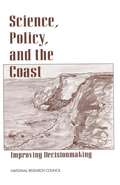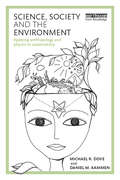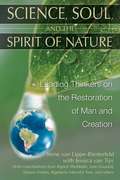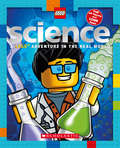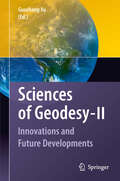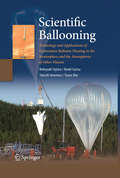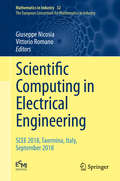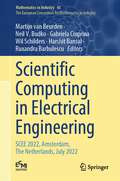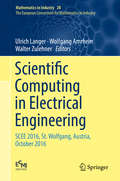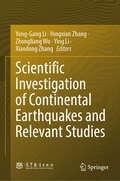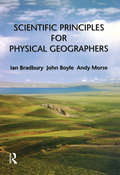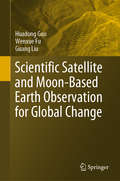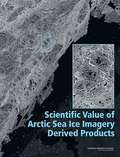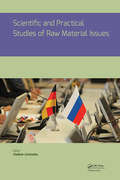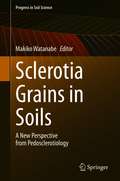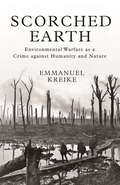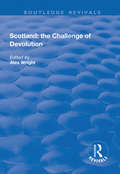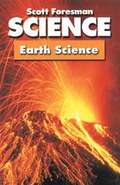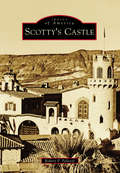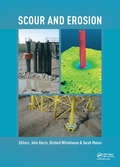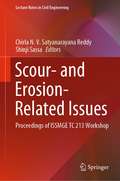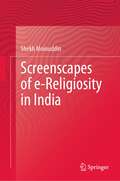- Table View
- List View
Science, Policy, and the Coast: Improving Decisionmaking
by Committee on Science Policy for the Coastal OceanThis book summarizes three symposia that were convened in the California, Gulf of Maine, and Gulf of Mexico regions to seek new ways to improve the use of science in coastal policymaking. The book recommends actions that could be taken by federal and state agencies and legislatures, local authorities, scientists, universities, the media, nongovernmental organizations, and the public to yield better coastal decisions and policies. It is unique in that it resulted from a partnership among natural scientists, social scientists, and policymakers.
Science, Society and the Environment: Applying Anthropology and Physics to Sustainability
by Michael R. Dove Daniel M. KammenIn an era when pressing environmental problems make collaboration across the divide between sciences and arts and humanities essential, this book presents the results of a collaborative analysis by an anthropologist and a physicist of four key junctures between science, society, and environment. The first focuses on the systemic bias in science in favour of studying esoteric subjects as distinct from the mundane subjects of everyday life; the second is a study of the fire-climax grasslands of Southeast Asia, especially those dominated by Imperata cylindrica (sword grass); the third reworks the idea of ‘moral economy’, applying it to relations between environment and society; and the fourth focuses on the evolution of the global discourse of the culpability and responsibility of climate change. The volume concludes with the insights of an interdisciplinary perspective for the natural and social science of sustainability. It argues that failures of conservation and development must be viewed systemically, and that mundane topics are no less complex than the more esoteric subjects of science. The book addresses a current blind spot within the academic research community to focusing attention on the seemingly common and mundane beliefs and practices that ultimately play the central role in the human interaction with the environment.This book will benefit students and scholars from a number of different academic disciplines, including conservation and environment studies, development studies, studies of global environmental change, anthropology, geography, sociology, politics, and science and technology studies.
Science, Soul, and the Spirit of Nature: Leading Thinkers on the Restoration of Man and Creation
by Jane Goodall Rupert Sheldrake Masaru Emoto Irene van Lippe-Biesterfeld Jessica Van Tijn Rigoberta Menchú TumAn exploration of the relationship between humans and nature through conversations with 12 leading scientific and social visionaries • Explores the importance of the unification of humankind and nature as it relates to creation, destruction, diversity, and the spiritual health of the world • Contains interviews with Rupert Sheldrake, Jane Goodall, and Nobel Peace Prize-winner Rigoberta Menchú Tum, among others Society’s attitude toward nature has changed considerably over the years. Terms pertaining to the anthropocentric paradigm of "mankind in charge," such as supervisor or owner, have been replaced by caretaker or trustee. This approach, although more appropriate, still indicates a complete separation of humankind from nature. Yet increasing numbers of people have begun to feel that they are intrinsically part of nature. This concept of unity with the natural world--that we are nature--is gaining momentum among many innovative social reformers from many diverse fields. In Science, Soul, and the Spirit of Nature, Irene van Lippe-Biesterfeld interviews 12 respected visionary thinkers, representing all continents, about their deep connection with the earth and their views on the relationship between humanity and nature. Presented as a series of thought-provoking conversations, this book delves deeply into the many conceptions we hold about nature, showing that while many strides have been made in the area of its preservation, we must now take the next step. Each contributor adds insights into the urgent change in consciousness that we must adopt in order to heal and restore our holistic relationship with the earth that was emblematic of the first peoples--reminding us that a separation from and destruction of nature is a spiritual destruction of ourselves.
Science: LEGO Nonfiction
by Penelope Arlon<p>Did you know that the blue whale could blow up 1,250 balloons in a single breath? Or that the Earth's core is as hot as the surface of the sun? <p>Including information about almost every scientific topic in the universe, readers will find out everything they ever wanted to know about fascinating animals, electricity, energy, weather, our galaxy, technology of tomorrow, and so much more. They'll even meet real-life scientists and read all about their exciting work. Complete with hundreds of stunning photographs, fun facts, mini comics, and building ideas, LEGO Science is the perfect book for young readers curious about science. Includes a buildable scientist minifigure! <p>This is a fixed-format ebook, which preserves the design and layout of the original print book.</p>
Sciences of Geodesy - I
by Guochang XuThis reference and handbook includes contributions from the world's leading experts and describes the history, theory, development, research highlights, problems and future of the individual geodetic fields. The subjects include: Geodesy, Satellite Geodesy, Marine Geodesy, GPS / Galileo Systems, Navigation and Positioning, Aerogravimetry, Super-conducting Gravimetry, Adjustment and Filtering, Orbits Theory, Orbits Determination, Tectonics, Earth Rotation and Polar Motion, Earth Tide and Ocean Loading Tide, Satellite Altimetry, Remote Sensing, InSAR, etc.
Scientific Ballooning: Technology and Applications of Exploration Balloons Floating in the Stratosphere and the Atmospheres of Other Planets
by Naoki Izutsu Toyoo Abe Nobuyuki Yajima Takeshi ImamuraThe aim of this book is to introduce scientific ballooning to the many people who are interested in the use of balloons for scientific applications. The book offers a basic understanding of the engineering details and the scientific research giving rise to balloon activities going on today. Above all, the book will serve as a guidebook for young scientists and researchers seeking to become involved in space science and technology by participating in balloon projects. The book deals with three types of balloons: large stratospheric balloons used for scientific purposes, rubber balloons used for aerological observations, and planetary balloons to be used in the atmospheres of other planets. The book provides many figures and photographs, and offers a systematic description of balloon technologies and related matters from historical background to current research topics. The contents include a theoretical discussion of ballon shape design, analysis and synthesis of flight dynamics, actual launching procedure, flight operations, and typical applications of ballooning in various scientific fields. Detailed meteorological descriptions, especially of the Earth's stratosphere and the atmosphere of other planets, are provided for investigating actual flight behavior.
Scientific Computing in Electrical Engineering: SCEE 2018, Taormina, Italy, September 2018 (Mathematics in Industry #32)
by Giuseppe Nicosia Vittorio RomanoThis collection of selected papers presented at the 12th International Conference on Scientific Computing in Electrical Engineering, SCEE 2018, held in Taormina, Sicily, Italy, in September 2018, showcases the state of the art in SCEE.The aim of the SCEE 2018 conference was to bring together scientists from academia and industry, mathematicians, electrical engineers, computer scientists, and physicists, and to promote intensive discussions on industrially relevant mathematical problems, with an emphasis on the modeling and numerical simulation of electronic circuits and of electromagnetic fields. This extensive reference work is divided into five parts: Computational Electromagnetics, Device Modeling and Simulation, Circuit Simulation, Mathematical and Computational Methods, Model Order Reduction. Each part starts with a general introduction, followed by the respective contributions. The book will appeal to mathematicians and electrical engineers. Further, it introduces algorithm and program developers to recent advances in the other fields, while industry experts will be introduced to new programming tools and mathematical methods.
Scientific Computing in Electrical Engineering: SCEE 2022, Amsterdam, The Netherlands, July 2022 (Mathematics in Industry #43)
by Martijn Van Beurden Wil Schilders Neil V. Budko Gabriela Ciuprina Harshit Bansal Ruxandra BarbulescuThis volume comprises selected papers presented at the 14th International Conference on Scientific Computing in Electrical Engineering, SCEE 2022, held in Amsterdam, The Netherlands, in July 2022. The aim of the SCEE 2022 conference was to bring together scientists – mathematicians, electrical engineers, computer scientists, and physicists, from universities and industry – to have in-depth discussions of the latest scientific results in Computational Science and Engineering relevant to Electrical Engineering and to stimulate and inspire active participation of young researchers.This extensive reference work is divided into four parts: Part I Circuit Simulation and Design.- Part II Device Simulation.- Part III Computational Electromagnetics.- Part IV Mathematical and Computational Methods. Each part starts with a general introduction, followed by the respective contributions. The book will appeal to mathematicians and electricalengineers. Further, it introduces algorithm and program developers to recent advances in the other fields, while industry experts will be introduced to new programming tools and mathematical methods.
Scientific Computing in Electrical Engineering: Scee 2016, St. Wolfgang, Austria, October 2016 (Mathematics In Industry Ser. #28)
by Ulrich Langer Wolfgang Amrhein Walter ZulehnerThis collection of selected papers presented at the 11th International Conference on Scientific Computing in Electrical Engineering (SCEE), held in St. Wolfgang, Austria, in 2016, showcases the state of the art in SCEE. The aim of the SCEE 2016 conference was to bring together scientists from academia and industry, mathematicians, electrical engineers, computer scientists, and physicists, and to promote intensive discussions on industrially relevant mathematical problems, with an emphasis on the modeling and numerical simulation of electronic circuits and devices, electromagnetic fields, and coupled problems. The focus in methodology was on model order reduction and uncertainty quantification. This extensive reference work is divided into six parts: Computational Electromagnetics, Circuit and Device Modeling and Simulation, Coupled Problems and Multi‐Scale Approaches in Space and Time, Mathematical and Computational Methods Including Uncertainty Quantification, Model Order Reduction, and Industrial Applications. Each part starts with a general introduction, followed by the respective contributions. This book will appeal to mathematicians and electrical engineers. Further, it introduces algorithm and program developers to recent advances in the other fields, while industry experts will be introduced to new programming tools and mathematical methods.
Scientific Investigation of Continental Earthquakes and Relevant Studies
by Ying Li Zhongliang Wu Yongxian Zhang Yong-Gang Li Xiaodong ZhangThis book focuses on seismogenic and tectonic environments, seismogenic structures, seismogenic fault structures, earthquake physics, rupture dynamic process, source mechanism, earthquake seismic anomalies and risk assessment, exploration of prediction methods, earthquake disaster characteristics and disaster-causing mechanisms, ground motion prediction, as well as state-of-the-art techniques.
Scientific Ocean Drilling
by Committee on the Review of the Scientific Accomplishments Assessment of the Potential for Future Transformative Discoveries U.S.-Supported Scientific Ocean DrillingThrough direct exploration of the subseafloor, U. S. -supported scientific ocean drilling programs have significantly contributed to a broad range of scientific accomplishments in Earth science disciplines, shaping understanding of Earth systems and enabling new fields of inquiry. Scientific Ocean Drilling: Accomplishments and Challenges reviews the scientific accomplishments of U. S. -supported scientific ocean drilling over the past four decades. The book evaluates how the programs (Deep Sea Drilling Project [DSDP], 1968-1983, Ocean Drilling Program [ODP], 1984-2003, and Integrated Ocean Drilling Program [IODP], 2003-2013) have shaped understanding of Earth systems and Earth history and assessed the role of scientific ocean drilling in enabling new fields of inquiry. This book also assesses the potential for transformative discoveries for the next proposed phase of scientific ocean drilling, which is scheduled to run from 2013 to 2023. The programs' technological innovations have played a strong role in these accomplishments. The science plan for the proposed 2013-2023 program presents a strong case for the continuation of scientific ocean drilling. Each of the plan's four themes identifies compelling challenges with potential for transformative science that could only be addressed through scientific ocean drilling, although some challenges appear to have greater potential than others. Prioritizing science plan challenges and integrating multiple objectives into single expeditions would help use resources more effectively, while encouraging technological innovations would continue to increase the potential for groundbreaking science.
Scientific Principles for Physical Geographers
by Ian Bradbury John Boyle Andy MorseScience for Geography and Environment introduces students (and academics who need to brush up their knowledge!) to scientific principles in a lively and accessible way, allowing them to proceed through the text at their own pace. The book is structured thematically with a logical development of key topics, all linked by a comprehensive cross-referencing system. Concepts and principles will be grounded in everyday experience and exemplified by reference to geographical/environmental processes. The authors are also testing each stage of the text on their own students, thereby ensuring that student needs are given top priority in the book's development. Lively and relevant introduction to those scientific principles necessary to understand key processes occuring within the natural environment.
Scientific Satellite and Moon-Based Earth Observation for Global Change (Springer Remote Sensing/photogrammetry Ser.)
by Huadong Guo Wenxue Fu Guang LiuGlobal change involves complex and far-reaching variations in the Earth’s systems, and satellite observations have been widely used in global change studies. Over the past five decades, Earth observation has developed into a comprehensive system that can conduct dynamic monitoring of the land, the oceans and the atmosphere at the local, regional and even global scale. At the same time, although a large number of Earth observation satellites have been launched, very few of them are used in global change studies. The lack of scientific satellite programs greatly hinders research on global change. This book proposes using a series of global change scientific satellites to establish a scientific observation grid for global environmental change monitoring from space, and offers the first comprehensive review of lunar-based Earth observation. These scientific satellites could provide not only basic datasets but also scientific support in facilitating advances in international global change research.
Scientific Value of Arctic Sea Ice Imagery Derived Products
by National Research Council of the National AcademiesDuring the 1990s, a government program brought together environmental scientists and members of the intelligence community to consider how classified assets and data could be applied to further the understanding of environmental change. As part of the Medea program, collection of overhead classified imagery of sea ice at four sites around the Arctic basin was initiated in 1999, and two additional sites were added in 2005. Collection of images during the summer months at these six locations has continued until the present day. Several hundred unclassified images with a nominal resolution of 1 meter have been derived from the classified images collected at the 6 Arctic sites. To assist in the process of making the unclassified derived imagery more widely useful, the National Research Council reviewed the derived images and considered their potential uses for scientific research. In this book, we explore the importance of sea ice in the Arctic and illustrate the types of information--often unique in its detail--that the derived images could contribute to the scientific discussion.
Scientific and Practical Studies of Raw Material Issues
by Vladimir Litvinenko Lucy RichardsScientific and practical studies of raw material issues presents the contribution to the Russian-German raw materials forum. The main theme of the book is problematic issues of subsoil use, whereby the contributions are divided in two main parts: - Exploration, mining and processing, and - Mining services Paying much attention to complex processes in the mining industry, Scientific and practical studies of raw material issues will be of interest to academics and professional involved or interested in Mining Engineering and Earth Sciences.
Sclerotia Grains in Soils: A New Perspective from Pedosclerotiology (Progress in Soil Science)
by Makiko WatanabeThis book introduces what sclerotia grains are, and where and how they exist in soils, by compiling the results obtained from the studies on fungal sclerotia formed by Cenococcum geophilum (Cg) and related species, the visible black small grains persistent for a few thousand to ten thousands of years in forest soils and sediments. The chapters contain the results and discussions on the ecological distribution and regulating factors, characteristics, and function of Cg sclerotia grains, carried out by researchers from soil geography, soil science, soil microbiology, physiology, forestry, analytical chemistry, environmental chemistry, material science, and related disciplines. The anatomy of sclerotia grains in soil was realized in terms of interdisciplinary joint researches, which resulted in deepening understanding of the ecological function of the mesoscale organic component in soils. This book covers the natural history of sclerotia in soils, pedo-sclerotiology.
Scorched Earth: Environmental Warfare as a Crime against Humanity and Nature (Human Rights and Crimes against Humanity #38)
by Emmanuel KreikeA global history of environmental warfare and the case for why it should be a crimeThe environmental infrastructure that sustains human societies has been a target and instrument of war for centuries, resulting in famine and disease, displaced populations, and the devastation of people’s livelihoods and ways of life. Scorched Earth traces the history of scorched earth, military inundations, and armies living off the land from the sixteenth to the twentieth century, arguing that the resulting deliberate destruction of the environment—"environcide"—constitutes total war and is a crime against humanity and nature.In this sweeping global history, Emmanuel Kreike shows how religious war in Europe transformed Holland into a desolate swamp where hunger and the black death ruled. He describes how Spanish conquistadores exploited the irrigation works and expansive agricultural terraces of the Aztecs and Incas, triggering a humanitarian crisis of catastrophic proportions. Kreike demonstrates how environmental warfare has continued unabated into the modern era. His panoramic narrative takes readers from the Thirty Years' War to the wars of France's Sun King, and from the Dutch colonial wars in North America and Indonesia to the early twentieth century colonial conquest of southwestern Africa.Shedding light on the premodern origins and the lasting consequences of total war, Scorched Earth explains why ecocide and genocide are not separate phenomena, and why international law must recognize environmental warfare as a violation of human rights.
Scotland: the Challenge of Devolution (Routledge Revivals)
by Alex WrightThis title was first published in 2000. Linking politics with culture and society, this collection provides an overview of the Scottish Parliament and analyzes it in relation to UK, European and global regionalization.
Scott Foresman Science: Earth Science
by Scott ForesmanThis Scott Foresman Science: Earth Science textbook contains unit lessons on Life Science, Physical Science, Earth Science, and Human Body.
Scott Foresman Science: Earth Science (Grade #4)
by Scott ForesmanThe text contains chapters on Earth Science, viz., Measuring Weather, The Makeup of the Earth, Exploring the Oceans, and Movements in the Solar System.
Scotty's Castle
by Robert P. PalazzoScotty's Castle is a study in contrasts, much like its setting in Death Valley. While the castle is known worldwide and has been visited by hundreds of thousands of tourists, many myths persist. It is not a castle, nor was it owned by Walter E. Scott, known as "Death Valley Scotty." But the Spanish-style hacienda, also known as Death Valley Ranch, has always been linked to Scott. This book explores the fascinating history of Death Valley Scotty, Albert and Bessie Johnson (the true owners and builders of the castle), and the castle itself from construction to private living quarters to a tourist facility owned and operated by the National Park Service.
Scour and Erosion: Proceedings of the 8th International Conference on Scour and Erosion (Oxford, UK, 12-15 September 2016)
by John Harris, Richard Whitehouse & Sarah MoxonScour and Erosion includes four keynote lectures from world leading researchers cutting across the themes of scour and erosion, together with 132 peer-reviewed papers from 34 countries, covering the principal themes of: - internal erosion- sediment transport- grain scale to continuum scale- advanced numerical modelling of scour and erosion- terrestrial scour and erosion- river and estuarine erosion including scour around structures, and- management of scour/erosion and sediment, including hazard management and sedimentation in dams and reservoirs. Scour and Erosion is ideal for researchers and industry working at the forefront of scour and erosion, and has applications in both the freshwater and marine environments.
Scour- and Erosion-Related Issues: Proceedings of ISSMGE TC 213 Workshop (Lecture Notes in Civil Engineering #177)
by Shinji Sassa Chirla N. V. Satyanarayana ReddyThis book comprises chapters on scour and erosion related issues. It is an outcome of the International Society for Soil Mechanics and Geotechnical Engineering (ISSMGE) Technical Committee 213 Workshop on Scour and Erosion that was held on December 16, 2020. The ISSMGE TC213 Workshop was attended by 368 participants from 12 different countries worldwide. The contents of this book reflect recent advances in the mechanics and countermeasures of scour and erosion, including coastal protection, erosion control, etc. Covering practical issues of geotechnical engineering with academic and research inputs, this volume will be a useful reference for academia and industry alike.
Screenscapes of e-Religiosity in India
by Shekh MoinuddinThis book deals with three different subjects: geography, social media and religion equally to discuss e-religiosity in terms of screenscapes that shaped digital socialization processes wherein the role of digital devices in general and smartphones in particular are considered crucial and critical. The spatial dimension is the primary foundation of the book wherein both space and place are discussed in digital manifestations in spatial sense. Religiosity is discussed variably in a sense of spirituality, social theories, religions and images. The book uses some illustrations to understand image politics. Image politics is quintessential in the age of digital technologies when production and reproduction of images are not restricted to business only; rather it attracts politics too and politicians often use the same to make political scores against opponents. The book covers contemporary digital discourses of e-religiosity in a sense of screenscapes that often found pivot in daily discussions across social media platforms. Screenscapes are considered as mediated technologies when contents can be accessed from different social media apps to construct or deconstruct their views, narratives, discourses, ideas, emotions, and perceptions around religious images in day-to-day activities, practices, rituals, customs, traditions, faiths and beliefs. The used illustrations exclusively map Indian religious gestures, identities, values, and rituals in digital-spatial contexts. The book discusses seven major questions and argues the same across the chapters in varied representations and interpretations: How and to what extent has the meaning of religiosity changed in the digital age? What are the dimensions of e-religiosity in India? How are digital devices (re)shaping religiosity in terms of e-religiosity? How and to what extent digital devices are negotiating with social and cultural lives? What is digital spatiality? How and to what extent does social media influence religiosity?
